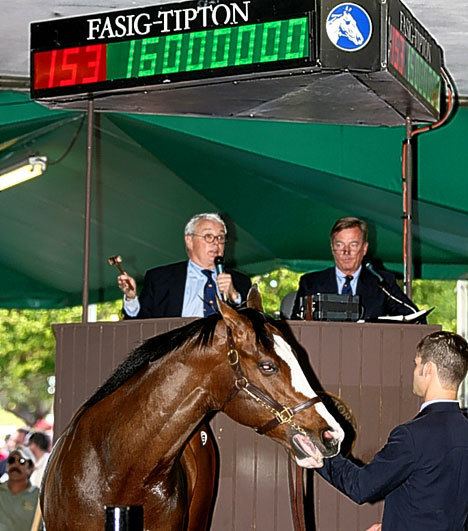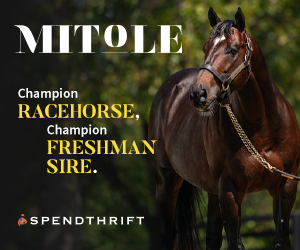
By: Steve Zorn
“Expensive horses don’t always run well. It’s a risk buyers are willing to take. They have plenty of money. What they don’t have is a good horse.”
—Francis Vanlangendonck, Summerfield Sales.
Back in the spring of 2005, two bidders with plenty of money – Demi O’Byrne for the Irish colossus Coolmore and John Ferguson for Sheikh Mohammed of Dubai – hooked up at the Fasig-Tipton two-year-old sale at Calder and pushed the price of a Forestry colt, who’d breezed an eighth of a mile in a then-unimaginable 9 4/5 seconds, to the absurd level of $16 million. Coolmore’s was the winning bid for a colt they named The Green Monkey, after a golf course in Barbados that some of the Coolmore principals frequented. It was then, and still remains, the highest price ever paid for a two-year-old thoroughbred.
As things turned out, The Green Monkey was not much of a racehorse. The best he could do was one third-place finish in just three lifetime starts, earning a total of $10,440. He was then retired to an equally ignominious stud career in Florida, which was cut short by health problems. He did, it is true, sire the winner of the Panamanian filly triple crown, as well as two US black-type winners, but that must have been a bit less than his buyers expected back in 2005. He was euthanized in 2017.
The Green Monkey is just the most egregious example of how an expensive two-year-old may not always run well. But he’s far from the only one. My friends at Two-Year-Old Sales Preview Watch have been parsing the data on these sales and have produced a number of very interesting lists of the success, or lack of it, that various buyers have had with juvenile auction purposes. (You can reach them on their Facebook page or directly at previewwatch@yahoo.com if you’re so inclined.) I’ve updated their list to be sure I’ve included the very latest earnings for all the horses, and I’ve added in the revenue when horses were sold as broodmare or stallion prospects, but even so, the figures strongly suggest that buying a two-year-old for a lot of money is a very good strategy for losing a lot of money.
Let’s consider the results for juveniles purchased for six- and seven-figures in the past decade from a number of vantage points; we’ll look at the results that a couple of major buyers have had, then at the results for two-year-olds that were so impressive at the sales that they rated a story in the BloodHorse. Whichever way you break down the statistics, it isn’t pretty.
Let’s start with the buyers. Perhaps the biggest purchaser of expensive two-year-olds over the past decade has been Terry Finley’s West Point Thoroughbreds partnerships, either alone or in partnership with other owners. From 2014 through 2019, West Point bought 48 six-figure juveniles and one – this year’s three-year-old Chestertown for seven figures. More than a third of these horses are still in training, including the aforementioned Chestertown, who most recently finished sixth, beaten 15 lengths, in the Peter Pan Stakes at Saratoga. So, there’s still lots of room for the group as a whole to increase its earnings. But the aggregate picture is not positive: over those six years, West Point and its partners paid $16,758,000 for the 49 auction purchases, an average of $342,000. Those same horses have, thus far, earned $4,962,848 on the race track, an average of $101,282. That might be a respectable number for a horse one bought for, say, $25,000, but it’s not great for a horse that cost well over $300,000.
Those 49 horses have so far won a total of 87 races, about 1.8 per horse, and have made a total of 487 starts, well below the national average. Those statistics of wins and starts per horse look even worse if one subtracts out the numbers for those horses that were claimed away from West Point and that have recorded many more starts and wins, albeit at lower levels, for their subsequent owners.
West Point, to be sure, has some success stories. Their current four-year-old Galilean, a $650,000 purchase two years ago, just won another stakes on the West Coast and has already earned over half a million dollars. West Point bought the now five-year-old Seven Trumpets, a stakes winner and Grade One-placed son of Tiznow’s son Morning Line, for $205,000 in 2017, and so far, the horse has earned $516,684 and perhaps has some residual value as a stallion prospect. The recently retired Gunmetal Gray, who more than covered his $225,000 purchase price with earnings of $284,700 (not taking into account training costs) was also, at last report, being evaluated as a potential stallion.
The Grade One-placed mare Best Performance was sold as a broodmare prospect for $560,000, after earning $398,448 on the track, more than covering her $350,000 purchase price. But overall, only six of those 49 expensive two-year-old even earned enough on the race track to match what West Point paid for them, and in two of those cases, the lifetime earnings include purses earned after the horses were claimed away from West Point.
Now let’s take a look at another kind of buyer, the wealthy entrepreneur. Robert and Lawana Low got their money from Low’s Prime, Inc., a highly successful trucking company. Over the years they’ve spent a lot of that income on thoroughbreds, the best known of which may be the ill-starred Magnum Moon, who won the Rebel Stakes and the Arkansas Derby before finishing 19th in the 2018 Kentucky Derby and never racing again. Magnum Moon contracted laminitis and was euthanized in 2019.
The Lows buy many of their horses as yearlings, but over the past two decades, they’ve purchased 21 juveniles at auction, most recently paying $1,200,000 last year for the Liam’s Map colt Colonel Liam, who won a first-level allowance at Saratoga just last week. Aside from Colonel Liam, only one other of those 21 juvenile purchases – the Grade 3-placed Intrepid Heart – is still running in their name, so it’s pretty safe to make a judgment on how they’ve done.
All told, the Lows paid $7,962,000 for those 21 horses, an average of just under $380,000 per horse. And, over their careers, the horses earned $3,173,979, or just under 40% of their purchase prices, without adjusting for the likely expensive training bills for 21 horses. Another caveat, a substantial share of those earnings came after the Lows lost the horses to claims or sold them privately; nine of the 21 juvenile purchases are currently racing or ended their careers in some other owner’s silks.
Still, the money they spent did get them some good horses. In addition to the three-year-old Colonel Liam, who could still, in racetrack parlance, be “any kind,” Steppenwolfer was third in the 2006 Kentucky Derby, Intrepid Heart and Federal Case were graded-stakes placed, and Agent Di Nozzo was a stakes winner before sliding down the claiming ladder. So, the Lows may well have gotten enough good horses to be satisfied with their monetary losses.
Here’s another way of looking at the data: what two-year-olds generated enough buzz, whether by way of fast breezes or high auction prices, to get written up in the BloodHorse? From 2008 through 2019, there were just 20 juveniles sold at auction who got that treatment. They ranged in sale price from the $2 million that West Point Thoroughbreds paid last year for Chestertown down to $250,000 for Angelcents, who was eased in the stretch in her second lifetime start and never raced again.
In the aggregate, those 20 juveniles cost $19,390,000, an average of just under $1 million each. On the race track, they earned a total of $3,542,409, an average of $177,120. But that average is a bit misleading. Nearly half the total purse earnings, $1.5 million, came from a single horse, Carpe Diem, winner of the Blue Grass and the Tampa Bay Derby, who now stands at Winstar Farm in Kentucky. And even Carpe Diem’s earnings on the track were less than his purchase price of $1,600,000. Backing Carpe Diem’s numbers out, the other 19 horses cost a total of $17,790,000 and earned just $2,022,609 on the track
One striking statistic from these 20 well-publicized juveniles is how little they actually raced. Three of the 20 never reached the starting gate at all, and the group as a whole averaged less than seven starts per horse. Most of these horses breezed very fast, but very few were at all durable in training. Only three of the 20, in fact, had as many as 12 lifetime starts. Were there some stakes horses in this elite group? Of course; half a dozen stakes winners or stakes-placed. And a couple – the aforementioned Carpe Diem and the broodmare Black Canary, who sold for $675,000 when she was done racing – went on to lucrative careers off the track. But perhaps there’s a better, or at least a cheaper, way to get a good horse?
So, what’s the takeaway re two-year-old sales? If you have all the money in the world and don’t mind redistributing some of it to breeders, pinhookers and (possibly some unscrupulous) bloodstock agents, then by all means go into the market. There are some good horses out there. But there are a lot more horses that you’ll spend six figures on and eventually let go for a $16,000 claim than there are expensive horses who will actually earn back their cost.
As I’ve shown in previous columns here at pastthewire.com and on my Business of Racing blog, most thoroughbred owners lose money on most of their horses. But if you’re of a mind to lose a lot of money quickly, then buying an expensive two-year-old is a pretty good strategy.



